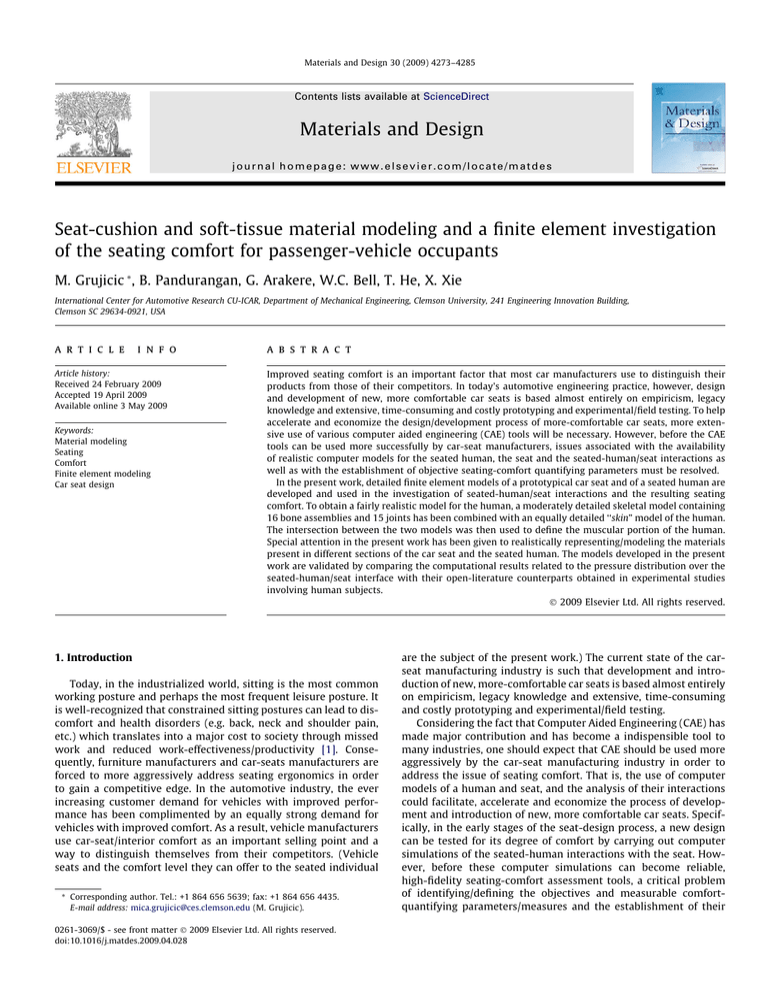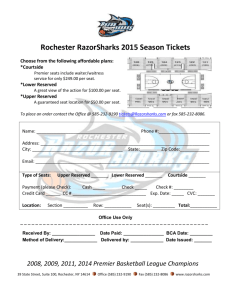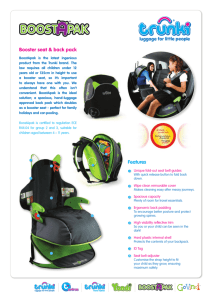
Materials and Design 30 (2009) 4273–4285
Contents lists available at ScienceDirect
Materials and Design
journal homepage: www.elsevier.com/locate/matdes
Seat-cushion and soft-tissue material modeling and a finite element investigation
of the seating comfort for passenger-vehicle occupants
M. Grujicic *, B. Pandurangan, G. Arakere, W.C. Bell, T. He, X. Xie
International Center for Automotive Research CU-ICAR, Department of Mechanical Engineering, Clemson University, 241 Engineering Innovation Building,
Clemson SC 29634-0921, USA
a r t i c l e
i n f o
Article history:
Received 24 February 2009
Accepted 19 April 2009
Available online 3 May 2009
Keywords:
Material modeling
Seating
Comfort
Finite element modeling
Car seat design
a b s t r a c t
Improved seating comfort is an important factor that most car manufacturers use to distinguish their
products from those of their competitors. In today’s automotive engineering practice, however, design
and development of new, more comfortable car seats is based almost entirely on empiricism, legacy
knowledge and extensive, time-consuming and costly prototyping and experimental/field testing. To help
accelerate and economize the design/development process of more-comfortable car seats, more extensive use of various computer aided engineering (CAE) tools will be necessary. However, before the CAE
tools can be used more successfully by car-seat manufacturers, issues associated with the availability
of realistic computer models for the seated human, the seat and the seated-human/seat interactions as
well as with the establishment of objective seating-comfort quantifying parameters must be resolved.
In the present work, detailed finite element models of a prototypical car seat and of a seated human are
developed and used in the investigation of seated-human/seat interactions and the resulting seating
comfort. To obtain a fairly realistic model for the human, a moderately detailed skeletal model containing
16 bone assemblies and 15 joints has been combined with an equally detailed ‘‘skin” model of the human.
The intersection between the two models was then used to define the muscular portion of the human.
Special attention in the present work has been given to realistically representing/modeling the materials
present in different sections of the car seat and the seated human. The models developed in the present
work are validated by comparing the computational results related to the pressure distribution over the
seated-human/seat interface with their open-literature counterparts obtained in experimental studies
involving human subjects.
Ó 2009 Elsevier Ltd. All rights reserved.
1. Introduction
Today, in the industrialized world, sitting is the most common
working posture and perhaps the most frequent leisure posture. It
is well-recognized that constrained sitting postures can lead to discomfort and health disorders (e.g. back, neck and shoulder pain,
etc.) which translates into a major cost to society through missed
work and reduced work-effectiveness/productivity [1]. Consequently, furniture manufacturers and car-seats manufacturers are
forced to more aggressively address seating ergonomics in order
to gain a competitive edge. In the automotive industry, the ever
increasing customer demand for vehicles with improved performance has been complimented by an equally strong demand for
vehicles with improved comfort. As a result, vehicle manufacturers
use car-seat/interior comfort as an important selling point and a
way to distinguish themselves from their competitors. (Vehicle
seats and the comfort level they can offer to the seated individual
* Corresponding author. Tel.: +1 864 656 5639; fax: +1 864 656 4435.
E-mail address: mica.grujicic@ces.clemson.edu (M. Grujicic).
0261-3069/$ - see front matter Ó 2009 Elsevier Ltd. All rights reserved.
doi:10.1016/j.matdes.2009.04.028
are the subject of the present work.) The current state of the carseat manufacturing industry is such that development and introduction of new, more-comfortable car seats is based almost entirely
on empiricism, legacy knowledge and extensive, time-consuming
and costly prototyping and experimental/field testing.
Considering the fact that Computer Aided Engineering (CAE) has
made major contribution and has become a indispensible tool to
many industries, one should expect that CAE should be used more
aggressively by the car-seat manufacturing industry in order to
address the issue of seating comfort. That is, the use of computer
models of a human and seat, and the analysis of their interactions
could facilitate, accelerate and economize the process of development and introduction of new, more comfortable car seats. Specifically, in the early stages of the seat-design process, a new design
can be tested for its degree of comfort by carrying out computer
simulations of the seated-human interactions with the seat. However, before these computer simulations can become reliable,
high-fidelity seating-comfort assessment tools, a critical problem
of identifying/defining the objectives and measurable comfortquantifying parameters/measures and the establishment of their
4274
M. Grujicic et al. / Materials and Design 30 (2009) 4273–4285
correlation with the subjective feeling of comfort has to be solved.
Among the comfort-quantifying parameters, the ones most frequently cited are: (a) the average human/seat contact pressure;
(b) the maximum human/seat contact pressure; (c) the human/seat
contact-area size and (d) the extent of symmetry of the human/seat
contact-area [2–14]. All of these comfort-quantifying parameters
are based on measurements of the distribution of human/seat contact pressure over the contact area and these measurements commonly suffer from several limitations, e.g. [15,16]: (a) they are
relatively difficult to perform reproducibly and with high accuracy;
(b) the obtained contact-pressure distributions do not provide any
information about internal stresses and deformations of the human
soft tissues and (c) the contact pressure distributions measured
provide only information about the normal stresses at the contact
human/seat interface whereas it is well established that significant
shear stresses can be present at the human/seat interface, e.g. [17–
22]. In addition, the contact-pressure distribution-measurement
approach has major deficiencies in its ability (or total lack thereof)
to provide information about the level of muscular activity and
about the magnitude of joint forces, two quantities which are certainly related to the seating comfort.
To address some of the shortcomings of the contact-pressure
distribution-measurement approach, various human-body/seat
coupled computer models and computational analyses were proposed. For example, a finite-element based modeling approach
was introduced by Verver et al. [23] and a rigid-body mechanical
based model was suggested by Langford et al. [24], etc. While these
approaches were able to provide estimates for some of the parameters that are either difficult or impossible to obtain via direct measurements, so far however, it has not been possible to create a
model that can calculate how muscular activity and joint forces
are affected by changes in sitting conditions. The main reason for
this is that the human body, in general, and its muscular and skeletal systems, specifically, are quite challenging mechanical systems to model.
To address the limitations of the seating-comfort assessment
computer modeling schemes mentioned above, the AnyBody Research Group [25] at Aalborg University in Denmark in collaboration with three furniture manufacturers recently initiated a
research project entitled ‘‘The Seated Human’’. The main objective
of this project is to define a set of seating-comfort design criteria
for chairs and to devise the means (based on rigorous computer
modeling of the human musculoskeletal system) for reliable
assessment of these criteria. Within the project, the recentlydeveloped novel technology for computer modeling of the human-body mechanics and dynamics, namely the AnyBody Modeling System [25] and its associated public domain library of body
models are being fully utilized and further developed. In its most
recent rendition [26], the AnyBody Modeling System enables creation of a detailed computer model for a human body (including all
important components of the musculoskeletal system) as well as
examination of the influence of different postures and the environment on the internal joint forces and muscle activity.
The earliest public-domain report related to the human body in
a seated posture can be traced back to the pioneering analytical
investigation conducted by Mandal [27,28] who used simple physics-based reasoning in place of the traditional empirical and subjective approaches. The main outcome of Mandal’s work was that
it is beneficial from the spinal-loads reduction point of view to reduce the pelvic rotation (i.e. flexion between the pelvis and the
thorax) below a normal value of 90o in the seated-human posture
(by tilting the seat-pan forward and/or the backrest backward). In a
recent multi-body dynamics based work carried out by Rasmussen
et al. [29–32] it was shown that forward seat-pan inclination indeed can reduce the spinal-joint loads. However, forward seatpan inclination was also found to increase the maximum muscle
activity (i.e. muscle fatigue) unless sufficient friction is present at
the human-buttocks/seat interface in which case its spinal-joint
load-reduction beneficial effect diminishes and is replaced with
an comfort-compromising/harmful effect of inducing shear forces
in the human soft tissue.
While the work of Rasmussen et al. [29–32] has made major
contributions to the field of seating comfort/discomfort, it has also
revealed some of the limitations of the multi-body dynamics musculoskeletal approach with respect to modeling the interactions
between the seated human and the seat. Simply stated, while the
multi-body dynamics approach can in general capture the overall
magnitudes of normal and shear interaction forces between the
seated human and the seat, the distribution of the forces over
the contact interface and their penetration into the human soft tissue could not be addressed. It appears clear that further progress in
the area of seating-comfort modeling and simulation will come
through additional advances in both the multi-body dynamics
musculoskeletal and finite-element analyses of the seated-human/seat interactions and by finding ways to cooperatively and
interactively engage these two modeling/simulation approaches.
The main purpose of the present work is to introduce a fairly
detailed finite-element model for a seated human and for a generic
car seat and to carry out a preliminary computational finite element analysis of the seated-human/seat interactions in order to
help identify the factors which affect seating comfort/discomfort.
A review of the literature carried out as part of the present work
revealed several finite-element models of the seated human. However, all these models suffer from one or more serious limitations
such as: (a) over-simplification of the geometry of the skeletal
and/or muscular portions of the model [16,19,33–35]. As explained
before, the maximum human/seat contact pressure and its distribution are related to the seating comfort. It is well-established that
the maximum contact pressure occurs under the ischial tuberosities
and for a finite-element model to correctly predict the location of
the maximum contact pressure it must provide an accurate geometrical description of the skeletal system of the human body;
(b) excessive coarseness of the finite-element mesh used in order
to reduce the computational cost [36–38] which yields to less
accurate computational results and (c) geometrical details of the
skeletal and the muscular systems are obtained from different
sources and they are somewhat inconsistent [39].
2. Modeling and computational procedures
2.1. Finite element model of the car seat
A generic car-seat finite element model was constructed within
this work, Fig. 1. First, a solid-geometrical model was developed
using CATIA V5, a CAD computer program [40]. Then, the CAD
model was pre-processed using HyperMesh, a general purpose
analysis pre-processing software [41] to construct a meshed model
with all the required sections, materials, joints, initial and boundary condition definitions.
The car-seat model comprised five shell components (foot-rest,
seat-base, seat-pan back-face, back-rest back-face and head-rest
back-face) and three solid components (seat-pan, back-rest and
head-rest), Fig. 1. The shell components were meshed using
3,220 three-node first-order shell finite elements while the solid
sections were discretized using 21,200 four-node first-order tetrahedron solid finite elements.
The shell sections of the car seat were constructed using low-carbon steel with a Young’s modulus of 210 GPa and a Poisson’s ratio of
0.3. Since the loading experienced by the seat is solely caused by the
weight of the seat occupant, and is hence not excessively high, plasticity of the steel components of the seat was not considered.
4275
M. Grujicic et al. / Materials and Design 30 (2009) 4273–4285
Nominal Compressive Stress, MPa
0
-0.05
-0.1
-0.15
-0.2
-0.25
(a)
-0.8
-0.7
-0.6
-0.5
-0.4
-0.3
-0.2
-0.1
0
Nominal Compressive Strain
0.35
Fig. 1. Finite element model for the car seat used in the present work.
Solid sections of the seat were constructed using a hyperelastic
foam (a poly-urethane seat-cushion like) material. This material
was represented using a non-linear isotropic compressible hyperelastic foam (i.e., a ‘‘hyperfoam”) material model. Within the hyperelastic foam material model formulation, the unique (generally
non-linear) relation between the stress and the strain measures
is represented using an elastic strain-energy potential function,
W, in the form:
W¼
N
X
2li ^ai ^ai ^ai
1 el ai bi
þ
k
þ
k
3
þ
ððJ
Þ
1Þ
k
2
3
bi
a2i 1
i¼1
ð1Þ
where N (=1, 2, 3) is the polynomial model order li, ai and bi are
1
^
temperature-dependent
material
parameters;
ki ¼ ðJth Þ3 ki ;
el
el
^
k1 ^
k2 ^
k3 ¼ J and kis are the principal stretches. J is the elastic-deformation volume-change ratio and Jth is the thermal-strain volumechange ratio. The coefficient bi controls the degree of compressibility
and is related to the Poisson’s ratio, mi. It should be further noted that
in order to account for the thin cell-wall closed-cell structure of the
foam which allows wall buckling under pressure without lateral
resistance/constraints, principal stresses/strains are assumed to be
fully de-coupled. In other words, the Poisson’s effect was neglected
and the Poisson’s ratio set to zero.
In the present work, a second order (i.e. N = 2) strain energy
hyperfoam potential function was used. Parameterization of this
model was done by providing to ABAQUS/Standard (the generalpurpose finite-element package used in the present work [50]) uniaxial-compression and simple-shear nominal stress vs. nominal
strain experimental test data, Fig. 2a and b. The data were obtained
in an experimental investigation carried out in accordance with
ASTM 3574-01 [48]. ABAQUS/Standard then performs a non-linear
least-squares fit of the provided test data to determine the hyperfoam model parameters li, ai and bi. This procedure yielded the following results: l1 = 164.861 kPa, a1 = 8.88413, and b1 = 0.0, and
l2 = 0.023017 kPa, a2 = 4.81798, and b2 = 0.0. Within the hyperfoam material model used in the present work, principal components of the stress (more precisely, principal components of the
Cauchy stress tensor, r) are obtained by differentiating the strain
energy function W with respect to the principal stretches, kis, as:
Nominal Shear Stress, MPa
0.3
0.25
0.2
0.15
0.1
(b)
0.05
0.1
0.2
0.3
0.4
0.5
0.6
0.7
0.8
0.9
Nominal Shear Strain
Fig. 2. (a) Uniaxial compression and (b) Simple shear test data used in the
construction of the non-linear elastic part of the hyperfoam material model.
ri ¼ Jel 1 ki
@W
@ki
ð2Þ
Since the polyurethane foam modeled in the present work falls into
the class of elastomeric-foam materials, which displays viscoelastic
behavior, viscoelasticity was added to the hyperelastic model described above. To define the viscoelastic portion of the seat-cushion
foam model, a time-based Prony-series model for the shear modulus was used. Since time dependency of the bulk modulus is generally quite weak in this type of material, the viscoelastic portion of
the material model was confined to the shear modulus. Within this
model, the time-dependent shear modulus, G(t), is defined in terms
of the instantaneous shear modulus, G0, as:
GðtÞ ¼ G0 N
X
st
Gi ð1 e
i
Þ
ð3Þ
i¼1
where Gi (the relaxation magnitude) and si (the relaxation time) are
material dependent parameters and N is the order of the Prony-series (N = 2 in the present work).
The viscoelastic portion of the foam model is defined in the present work by providing ABAQUS/Standard with the experimental
normalized shear modulus, G(t)/G0 vs. time relaxation data, Fig. 3.
4276
M. Grujicic et al. / Materials and Design 30 (2009) 4273–4285
These data are filled using a non-linear least squares procedure to
define the viscoelastic material parameters, Gi and si. This procedure yielded the following results: G1 = 0.3003 and s1 = 0.010014
s, and G2 = 0.1997 and s2 = 0.1002 s. It should be noted that while
the viscoelastic part of the elastomeric-foam material; model was
developed and parameterized in the present work, due to static nature of the computational analysis used, the role of viscoelasticity
was immaterial.
what) simplifying and re-posturing the human-body skeleton
model downloaded from the AnyBody Repository [42], Fig. 4, and
combining it with a human-body shell model developed by F. Summer [43], Fig. 5. The human-body skeleton model used included a
fairly detailed anatomical description of the main bony structures
(e.g. the iliac wings comprising the ischial tuberosities, sacrum, coccyx and femora). The intersection of the two models was used to
define the portion of the human body filled with soft tissue
2.2. Finite element model of the seated human
A new finite element model of the seated human was developed
within the present work. The model was constructed by (some-
Normalized Relaxation Shear Modulus
1
0.9
0.8
0.7
0.6
0.5
0.1
0.2
0.3
0.4
0.5
0.6
0.7
0.8
Time, sec
Fig. 3. Normalized shear modulus relaxation data used in the construction of the
viscoelastic portion of the hyperfoam material model.
Fig. 5. Finite element model for the muscular portion of the seated human analyzed
in the present work.
Fig. 4. Finite element model for the skeletal portion of the seated human analyzed
in the present work.
Fig. 6. A typical configuration of the seated-human/car-seat assembly used in the
present work.
M. Grujicic et al. / Materials and Design 30 (2009) 4273–4285
(muscles, ligaments and fat). The outer surface of the model was
covered with skin while the skeletal portion of the model was filled
with (hollow) bones. The skin portion of the human body model
was meshed using ca. 60,000 three-node shell elements, the softtissue portion with ca. 135,000 four-node first-order tetrahedron
elements while the bones were meshed using ca. 30,000 threenode shell elements. Equivalent nodes were used between the skin
and the soft tissue as well as between the soft tissue and the bones.
Three different materials (bones, soft-tissue muscle/fat and
skin) are used in the construction of the seated-human finite-element model.
Following the work done in Refs. [44,45], the skin was modeled
as a linearly-elastic isotropic nearly-incompressible material with
a Young’s modulus of 0.15 MPa, a Poisson’s ratio of 0.46 and an
average density of 1100 kg/m3.
Individual bones of the skeletal portion of the human-body
model are constructed using a rigid (non-deformable) material
4277
with densities adjusted to yield accurate bone masses. The use of
the rigid-material approximation was justified by the fact that
the extents of deformation experienced by the bones are so small
in comparison to that experienced by the soft tissue, that it can
be ignored. Various (e.g. spherical, revolute, etc.) connectors were
used to represent the joints connecting adjacent bones. For example, a spherical joint was placed between the lumbar spine and the
pelvis, two spherical joints representing hips were placed between
the iliac wings and the two femur bones, two revolute (knee) joints
were placed between the femora and the lower legs, etc. A total of
15 connectors/joints were used in the skeletal portion of the human-body model.
The muscular portion of the human-body was modeled using a
Mooney–Rivlin hyperelastic isotropic material model. This model
is capable of accounting for large (non-linear) elastic deformations
that soft tissue of the seated human can be subjected to, due to human/seat interactions. In the literature, it is well-established that a
Fig. 7. A comparison between the contact pressure distribution over the seat-pan top surface obtained: (a) experimentally, in Ref. [23] and (b) computationally, in the present
work.
4278
M. Grujicic et al. / Materials and Design 30 (2009) 4273–4285
non-linear hyperelastic isotropic material model is a best compromise between physical reality and computational efficiency when
dealing with the human-body soft tissue. However, the type(s) of
the hyperelastic isotropic material model and their parameterizations vary widely [15,16,19,39,45–47]. Within the hyperelastic
isotropic material model formulation, the unique (generally nonlinear) relation between the stress and the strain measures is
represented using an elastic strain-energy potential function.
Within the Mooney–Rivlin model used in the present work, the
strain-energy potential function, W, is defined as:
2
W ¼ A1 ðJ 1 3Þ þ A2 ðJ 2 3Þ þ A3 ðJ 2
3 1Þ þ A4 ðJ 3 1Þ
ð4Þ
where J1, J2 and J3 are the three invariants of the Cauchy–Green
strain tensor, C, defined as:
C ¼ FT F
ð5Þ
with F being the deformation-gradient tensor and superscript ‘‘T”
denotes a transverse of the tensor in question. The three invariants
of the C tensor are defined respectively as:
J 1 ¼ traceðCÞ
J2 ¼
1
½trace2 ðCÞ traceðC 2 Þ
2
J 3 ¼ detðCÞ
ð6Þ
ð7Þ
ð8Þ
In Eq. (4), the material-dependent parameters A3 and A4 are related
to the other two parameters, A1 and A2, as:
A3 ¼
1
A 1 þ A2
2
ð9Þ
and
A4 ¼
A1 ð5m 2Þ þ A2 ð11m 5Þ
2ð1 2mÞ
ð10Þ
Following the investigations described in Refs. [15,16,19,39,45–47],
using the experimental compression-force vs. displacement rigid
flat-ended cylindrical-punch data reported in Ref. [49] and the finite-element/optimization procedure described in Appendix, A1,
A2 and m were determined and respectively assigned the following
values: 1.65 kPa, 3.35 kPa and 0.49.
Stress (more precisely, the second Piola–Kirchhoff stress tensor,
S) is obtained by differentiating the strain energy function W with
respect to the right Cauchy–Green strain tensor, C, as:
S¼2
@W
@C
ð11Þ
The (true) Cauchy stress, r, can then be computed from the corresponding second Piola–Kirchoff stress, S, using the following component-form relation:
rrk ¼ F ri Sij F kj Jel;1
ð12Þ
Fig. 8. Typical contact pressure distribution over the human-body/car-seat interface for the case of a seat-human with: (a) supported feet and (b) dangling feet.
M. Grujicic et al. / Materials and Design 30 (2009) 4273–4285
2.3. Seated-human/seat contact/interactions
In the seated-human/car-seat interaction analyses carried out
in the present work, the shell sections of the seat are first positioned to obtain the desired seat-pan and back-rest inclination angles. Subsequently, their positions are kept fixed.
The loading present in the seated-human/car-seat interaction
analyses is associated solely with the weight of the seated-human.
In other words, only the distributed gravity-based body forces
were used to prescribe the loading.
The interactions between the seated human and the seat, between human feet and the foot-rest as well as potential human
soft-tissue and seat self-interactions are analyzed in ABAQUS/Standard using a ‘‘penalty” contact method within which the penetration of the surfaces into each other is resisted by linear spring
forces/contact-pressures with values proportional to the depth of
penetration. These forces, hence, tend to pull the surfaces into an
equilibrium position with no penetration. Contact pressures between two bodies are not transmitted unless the nodes on the
‘‘slave surface” contact the ‘‘master surface”. There is no limit to
the magnitude of the contact pressure that could be transmitted
when the surfaces are in contact. Transmission of shear stresses
across the contact interfaces is defined in terms of a static and a kinetic/sliding friction coefficient and an upper-bound shear stress
limit (a maximum value of shear stress which can be transmitted
before the contacting surfaces begin to slide). A typical seated-hu-
4279
man/car-seat configuration analyzed in the present work is shown
in Fig. 6.
As mentioned earlier, all the calculations in the present work
were done using ABAQUS/Standard [50]. A typical quasi-static
computational analysis of the seated-human/car-seat interactions
carried out on a 64 bit Windows XP based PC with two quad-core
2.83 GHz Xenon processors (eight total cores) and 8 GB of RAM required ca. 30 min of wall-clock time.
2.4. Seated-human/car-seat model validation
To validate the present model for the seated-human/car-seat
assembly, the computational results obtained in the present work
related to the distribution of pressure over the human/seat contact
interface as well as the size and shape of this interface are compared
with their experimental counterparts reported in Ref. [23]. Toward
that end, the seat-pan has been replaced with a cubical-shaped foam
block with the dimension is L W H = 400 mm 400 mm 60 mm. The seat-pan is divided in three through-the-thickness
layers and each layer meshed using eight-node first-order solid elements with the dimensions L W H = 25 mm 25 mm 20 mm. In this way, the size of the upper-face of the elements was
made equal to the size of the pressure plates used in the experiments
required in Ref. [23]. In Ref. [23], a 16 16 sensor pressure-mapping
system with a sampling rate 3072 readings per second and a calibrated pressure range of 0–200 mmHg was used.
Fig. 9. Typical contact shear stress distribution over the human-body/car-seat interface for the case of a seat-human with: (a) supported feet and (b) dangling feet.
4280
M. Grujicic et al. / Materials and Design 30 (2009) 4273–4285
An example of the comparison of the computational and
the experimental results from Ref. [23] is displayed in Fig. 7a
and b. Due to copyright restrictions, the experimental results
reported in Ref. [23], had to be read-off from this reference and
re-plotted Fig. 7a. A comparison between the results presented in
Fig. 7a and b suggest that there is a quite good agreement between
the experimental findings and the present modeling approach.
Specifically, in both cases the maximum pressure is around
30 kPa and it is located under the ischial tuberosities while the overall size and shape of the contact-surface patches are quite comparable. Thus, to a first order of approximation, the present model
can be relied on for further investigation of seated-human/car-seat
interactions.
3. Results and discussion
The car-seat and the seated-human finite element models (as
well as the seat-cushion and the human soft-tissue material models) developed in the present work and reported in the previous
section and in the Appendix enable preliminary investigation of
comfort of the seated human. Two specific seating postures were
considered: (a) a seating posture in which the feet of the human
were supported by the foot rest (referred to as the ‘‘supported feet
case”), and (b) a seating posture where the feet were not supported
by the foot rest (referred to as the ‘‘dangling feet case”). The results
of this preliminary investigation are presented in the remainder of
this section.
3.1. Contact-pressure distribution and contact patch(es) size/shape
As stated earlier, distribution of the contact pressure over the
seated human/car-seat contact interface is an important factor in
controlling seating comfort. Typical distributions of the contact
pressure in the supported feet and dangling feet cases are shown
in Fig. 8a and b, respectively. The results displayed in these figures
can be related to the seating comfort in the following ways: (a) the
magnitude and the location of the maximum contact pressure can
be determined. As was expected, the results displayed in Fig. 8a
show that the maximum pressure in the supported feet case was
located at ischial tuberosities (a rounded protuberance associated
with the lowest of the three pelvis bones), while Fig. 8b shows that
the maximum pressure in the dangling feet case was centered on
the mid-span of the hamstring. Also, it should be noted that contact pressures are lower in the supported feet case; (b) the distribution of the pressure over the contact interface. It is well
established that lower maximum contact pressure and more uniform distribution of the pressure over the human-body/car-seat
contact area imply improved seating comfort; (c) the size and (d)
the shape/symmetry of the contact area. Larger and more symmetric contact surface(s) are associated with increased seating comfort, in general.
Fig. 10. Distributions of the von Mises equivalent stress over a section-cut along a sagittal (x-y) plane through the left ischial tuberosity for the case of a seat-human with: (a)
supported feet and (b) dangling feet.
M. Grujicic et al. / Materials and Design 30 (2009) 4273–4285
3.2. Distribution of contact shear stresses
As pointed out earlier, conventional experiments aimed at
quantifying the interactions between a seated human and a car
seat can only deal with normal contact stresses. However, contact
shear stresses can also develop at the contact interface(s) (particularly in the case when the backrest is reclined backward and the
human is leaning against it). It is commonly known that prolonged
exposure to contact shear stresses can cause soft-tissue trauma in
wheel-chair bound disabled people, elderly or diabetic patients. In
these individuals, the consequences of soft-tissue trauma can be
quite severe and can lead to ulcers and tissue necrosis. While
healthy individuals with proper skin sensation generally change
their position/posture before significant tissue trauma occurs, contact shear stresses clearly contribute to the perception of seating
discomfort in these individuals.
Typical distributions of the longitudinal contact shear stress
in the supported feet and dangling feet cases are shown in
Fig. 9a and b, respectively. It should be noted that the results
displayed in Fig. 9a and b were obtained under the constant
static friction coefficient condition of 0.5 (corresponding roughly
to the case of a clothed human body sitting on a fabric upholstered car seat.) Clearly, in the absence of friction, no contact
shear stresses can be developed at the seated-human/car-seat
interface. In should be further observed that somewhat higher
4281
longitudinal contact shear stresses exist in the supported feet
case, the case for which the contact normal stresses were found
to be lower.
3.3. Stresses within the human body
The results presented in the previous two sections deal with
contact normal and shear stresses, i.e. with the stresses present at
the seated-human/car-seat contact interfaces. It is generally recognized that not only these contact stresses but also the stresses distributed within the human body in the regions adjacent to the
contact interface can greatly contribute to the perception of seating
discomfort. While at the present time these in-body stresses cannot
be measured experimentally, they can be readily computed using
finite element analyses of the human-body/car-seat interactions,
like the one developed in the present work. Examples of the computed results of in-body stresses are displayed in Figs. 10–12. In
these figures, the distribution of von Mises equivalent stress over
three vertical sections of the human body model is displayed for
two seating posture cases. The results displayed in Fig. 10a and b
correspond to the case of a section-cut along a sagittal (x-y) plane
through the left ischial tuberosity. A comparison of the results
displayed in Fig. 10a and b reveals that the in-body stresses are
somewhat higher and concentrated around the ischial tuberosity
in the supported feet case. While, in the dangling feet case, the
Fig. 11. Distributions of the von Mises equivalent stress over a sagittal plane cut through the coccyx for the case of a seat-human with: (a) supported feet, and (b) dangling
feet.
4282
M. Grujicic et al. / Materials and Design 30 (2009) 4273–4285
stresses are mainly localized under the hamstring. Fig. 11a and b
correspond to the case of a sagittal plane cut through the coccyx
(the tailbone, i.e. the final segment of the human vertebral column).
The results displayed in these Figures show relatively low levels of
the in-body stresses. This is justified by the fact that there is limited
contact between the human soft tissue just below the coccyx and
the seat pan, in both seating postures. Fig. 12a and b display the
case of a coronal (y-z) plane cut through the ischial tuberosities. A
comparison of the results displayed in Fig. 12a and b reveal significantly higher in-body stresses for the case of supported feet. This
finding is reasonable considering the fact that in the supported feet
case the majority of the human upper-body weight is supported by
the contact interfaces located directly below the ischial tuberosities.
Again, it should be recalled that within the coordinate system
chosen, x-axis is pointing forward, y-axis upward, and z-axis from
left to right.
3.4. Seating comfort evaluation
To make the results displayed in Figs. 8–12 useful, they should
be compared with the (subjective) corresponding results of the human-subjects’ perception of the seating comfort. In such studies,
the human-body model should be customized in order to most
accurately describe the stature, physical build, weight, and the
physical condition of the human test subject in question. This
can be done through proper scaling of the generic human-body
model like the one developed in the present work.
It should be noted that, as mentioned earlier, maximum muscle activity also contributes to the perception of comfort. That is,
if the voluntary muscle forces (controlled by the human central
nervous system) required to maintain the given seating posture
of the human are higher, then there will be an increased perception of discomfort. At the present time muscles are not treated as
contractile actuation elements within the finite element models,
like the one developed in the present work. However, muscle
activities can be computed via the use of musculoskeletal multi-body dynamics programs like AnyBody Modeling System [25].
An example of the muscle activation results which can be
obtained through the use of the AnyBody Modeling System is
shown in Fig. 13. In Fig. 13, muscles are depicted as purple-grey
lines while the extent of muscle activation can be denoted pictorially by the extent of muscle bulging. The results shown in
Fig. 13 were generated in our ongoing musculoskeletal investigation of seating comfort [51]. The two computational approaches
to seating comfort analysis, i.e. the finite-element approach and
the musculoskeletal multi-body dynamics approach, will be
Fig. 12. Distributions of the von Mises equivalent stress over a coronal (y–z) plane cut through ischial tuberosities for the case of a seat-human with: (a) supported feet, and (b)
dangling feet.
4283
M. Grujicic et al. / Materials and Design 30 (2009) 4273–4285
Acknowledgements
A portion of the material presented in this paper is based on the
use of the AnyBody Modeling System, a musculoskeletal multibody dynamics software [25]. The authors are indebted to Ozen
Engineering for donating an AnyBody Modeling System license to
Clemson University.
Appendix A. Parameterization of the human soft-tissue
Mooney–Rivlin hyperelastic material model
Fig. 13. A musculoskeletal model used in the ongoing AnyBody System Modeling
investigation of seating comfort [51].
combined in our future work to construct a seating comfort
metric. The starting point in this effort will be the so-called
discomfort function proposed by Rasmussen and de Zee [31]
which combines properly-weighted squared total shear force between the seat-pan and the human buttocks and the maximum
muscle activity.
4. Summary and conclusions
Based on the results obtained in the present work, the following
main summary remarks and conclusions can be drawn:
1. In order to investigate seated-human/car-seat interactions and
their effect on human perception of seating comfort and fatigue,
fairly detailed and anatomically correct finite element models
have been developed for an average male human body and for
a prototypical car seat.
2. One of the critical steps in development of the human-body
model was a material-modeling of human soft tissue (skin,
muscle and fat). This was accomplished through the use of a
simple optimization procedure in conjunction with experimental and computational results pertaining to the force vs. displacement curves obtained in flat-head cylindrical rigid-punch
indentation tests.
3. The seated-human/car-seat assembly was validated by matching the available contact pressure experimental results from
the literature with the computational results obtained in the
present work.
4. A computational finite-element investigation of the seatedhuman/car-seat interaction was used to compute a number of
quantities (contact pressure, contact shear stresses, and in-body
stresses) which can be related to the seat-occupant’s perception
of seating comfort.
It is well-established that human soft-tissue behaves as a nonlinear hyperelastic, viscoelastic, anisotropic and inhomogeneous
material. To simplify mathematical modeling of the mechanical response of human soft-tissue (while retaining the physical reality)
various assumptions are often utilized. Among these assumptions
the following will be employed in the present work: (a) initial
isotropy; (b) local homogeneity; and (c) time-invariant (i.e. nonviscoelastic) material behavior (mainly due to a lack of reliable
data).
In accordance with the assumptions listed above, soft tissue is
modeled using a Mooney–Rivlin hyperelastic material model
which, in accordance with Eqs. (4), (9), and (10) contains three
material-dependent parameters: A1, A2, and m. These parameters
were determined in the present work by fitting the compressionforce vs. compression-strain data obtained in Ref. [48] (using a
flat-head cylindrical rigid-punch indentation procedure) to the
corresponding results obtained computationally in the present
work (via the use of a finite element analysis). Details of this fitting
procedure are described below.
A simple schematic of the flat-head cylindrical rigid-punch
indentation soft-tissue mechanical-property characterization test
is depicted in Fig. A1. In Fig. A1, the key experimental quantities
are denoted as: P – indentation force, h – specimen thickness, w
– depth of indentation and a – the punch radius.
To determine the three unknown Mooney–Rivlin hyperelastic
soft-tissue material parameters (A1, A2, and m), an axisymmetric finite element model of the flat-head cylindrical rigid-punch indentation experiment was constructed, Fig. A2a and b. To ensure that
the finite-element results are not significantly affected by the mesh
size, a mesh-convergence analysis was undertaken for each choice
of material parameters A1, A2, and m. Additional details of the finiteelement procedure used are provided below. The (static) finite element analysis yielded a unique P vs. w/h curve. To determine the
optimal values of A1, A2, and m, the finite-element analysis of the
flat-head cylindrical rigid-punch indentation test was coupled with
a simple gradient-free Nelder-Mead simplex optimization algorithm in which the sum of squares of the differences between
the measure and computed indentation force, P, at a given level
of indentation, w, was treated as the objective function and minimized. Additional details of the optimization procedure used are
P
a
Punch
w
h
Soft Tissue
Rigid Substrate
Fig. A1. Schematic of typical flat-head cylindrical rigid-punch indentation experiment used to determine the mechanical properties of soft tissue.
4284
M. Grujicic et al. / Materials and Design 30 (2009) 4273–4285
Fig. A2. (a) The initial, and (b) a deformed finite-element mesh used in the present investigation of the flat-head cylindrical rigid-punch indentation experiment.
-2
-4
Force, N
-6
-8
-10
-12
Experimental Data
-14
Polynomial Fit
-16
-0.5
-0.4
-0.3
-0.2
-0.1
Nominal Strain
Fig. A3. Typical agreement between the experimental and the computational
results pertaining to the flat-head cylindrical rigid-punch indentation experiment.
provided below. The resulting optimal values of A1, A2, and m are reported in Section 2.2. An example of the typical agreement between the experimental and the computational P vs. w results
obtained in the present work is displayed in Fig. A3.
As mentioned above, the finite-element model employed in this
portion of the work was two-dimensional axisymmetric and based
on a finite-deformation formulation. The model was meshed using
quadrilateral CAX8H and triangular CAX6H quadratic elements in
order to improve the ability of the model to deform to large strains.
The flat-headed cylindrical punch was modeled as a rigid body
with a radius of 3 mm and a fillet radius of 0.2 mm. Punch/soft-tissue sample contact was treated as frictionless. To simulate the
indentation test, a vertical displacement was prescribed, and the
corresponding reaction force at the punch reference node was calculated. The bottom surface of the soft-tissue sample was constrained in the vertical direction to account for testing on a hard
substrate and assigned a frictionless-type contact/boundary condition. Only the loading behavior of the soft-tissue material was
investigated and, hence, the dissipative components of the response were neglected.
As mentioned above, to carryout model parameterization (i.e.
parameter identification), an iterative inverse finite-element problem was constructed so that the unknown material-model parameters are determined from the condition that a satisfactory
agreement is attained between model-predicted and experimentally-measured load vs. nominal strain curves. Clearly, parameter
identification is an optimization problem in three-dimensional A1
– A 2 –m parameter space with the objective function (to be minimized) being the mean squared error (MSE) between the modeled
and experimental force vs. nominal strain curves. Optimization
was carried out by coupling HyperStudy computer software from
Altair Engineering [52] with ABAQUS/Standard. To increase the
likelihood of finding the global solution, rather than a local
minimum, the optimization algorithm was employed using
M. Grujicic et al. / Materials and Design 30 (2009) 4273–4285
different initial points in the parameter space. An optimization
termination condition was defined as either a maximum of 1000
iterations or the normalized simplex diameter smaller than
0.0001. A typical parameter identification analysis carried out on
a 64 bit Windows XP based PC with two quad-core 2.83 GHz Xenon
processors (eight total cores) and 8 GB of RAM required ca. 40 min
of wall-clock time.
References
[1] Johansen U, Johren A. Personalekonomi idag. Uppsala Publishing House; 2002.
ISBN: 9170052026.
[2] Ebe K, Griffin MJ. Factors effecting static and seat cushion comfort. Ergonomics
2001;41(10):901–92.
[3] Inagaki H, Taguchi T, Yasuda E, Iizuka Y. Evaluation of riding comfort: from the
viewpoint of interaction of human body and seat for static, dynamic and long
time driving. In: SAE conference, SAE no. 2000-02-0643; 2000.
[4] Kamijo K, Tsujimura H, Obara H, Katsumata M. Evaluation of seating comfort.
In: SAE conference, no. 820761; 1982.
[5] Lee J, Grohs T, Milosic M. Evaluation of objective measurement techniques for
automotive seat comfort. In: SAE conference, SAE no. 950142; 1995.
[6] Milvojevich A, Stanciu R, Russ A, Blair GR, van Heumen JD. Investigating
psychometric and body pressure distribution responses to automotive seating
comfort. In: SAE conference, SAE no. 2000-01-0626; 2000.
[7] Park SJ, Kim CB. The evaluation of seating comfort by objective measures. In:
SAE conference, SAE no. 970595; 1997.
[8] Park SJ, Lee YS, Nahm YE, Lee JW, Kim JS. Seating physical characteristics and
subjective comfort: design considerations. In: SAE conference, SAE no. 980653;
1998.
[9] Reed MP, Saito M, Kakishima Y, Lee NS, Schneider LW. An investigation of
driver discomfort and related seat design factors in extended-duration driving.
In: SAE conference, SAE no. 910117; 1991.
[10] Tewari VK, Prasad N. Optimum seat pan and back-rest parameters for a
comfortable tractor seat. Ergonomics 2000;43(2):167–86.
[11] Thakurta K, Koester D, Bush N, Bachle S. Evaluating short and long term seating
comfort. In: SAE conference, SAE no. 950144; 1995.
[12] Uenishi K, Fujihashi K, Imai H. A seat ride evaluation method for transient
vibrations. In: SAE conference, SAE no. 2000-01-0641; 2000.
[13] Yun MH, Donjes L, Freivalds A. Using force sensitive resistors to evaluate the
driver seating comfort. Adv Ind Ergon Safety IV 1992:403–10.
[14] Zhao LQ, Xia QS, Wu XT. Study of sitting comfort of automotive seats. SAE
conference, SAE no. 945243; 1994.
[15] Bader DL, Bowder P. Mechanical characteristics of skin and underlying tissues
in vivo. Biomaterials 1980;4:305–8.
[16] Oomens CWJ, Bosboom EMH, Bressers OFJT, Bouten CVC, Bader DL. Can loaded
interface characteristics influence strain distribution in muscles adjacent to
bony prominences. Comput Methods Biomech Eng 2003;6(3):171–80.
[17] Bader DL, Bowder P. Ischial pressure distribution under the seated person. In:
Bader DL, editor. Pressure stores – clinical practice and scientific approach;
1990. p. 223–33.
[18] Bennett L, Kauver D, Lee BY, Trainor FA. Shear vs. pressure as causative factors
in skin blood flow occlusion. Arch Phys Med Rehab 1979;60:309–14.
[19] Chow WW, Odell EI. Deformation and stresses in soft body tissues of a sitting
person. J Biomech Eng 1978;100:79–87.
[20] Krouskop TA, Garber SL, Noble P. Pressure management and the recumbent
person. In: Bader DL editor. Pressure sores – clinical practice and scientific
approach; 1990. p. 235–48.
[21] Reichel SM. shear force as a factor in decubitus ulcers in paraplegics. J Am Med
Assoc 1958;166:762–3.
[22] Scales J. Pressure sore prevention. Care Sci Pract 1982;1:9–17.
[23] Verver MM, van Hoof J, Oomens CW, Wismans JS, Baaijens FP. A finite element
model of the human buttocks for prediction of seat pressure distributions.
Comput Methods Biomech Biomed Eng 2004;7:193–203.
4285
[24] Langsfeld M, Frank A, van Deursen DL, Griss P. Lumbar spine curvature during
office chair sitting. Med Eng Phys 2000;22:665–9.
[25] AnyBody 3.1. Aalborg, Denmark: AnyBody Technology A/S; 2008.
[26] Damsgaard M, Rasmussen J, Christensen ST, Surma E, de Zee M. Analysis of
musculoskeletal systems in the anybody modeling system. Simulat Model
Pract Theory 2006;14:1100–11.
[27] Mandal AC. The seated man (homosedens) – the seated work position: theory
and practice. Appl Ergonom 1984;12:19–26.
[28] Mandal AC. The influence of furniture height on back pain. Behav Inform
Technol 1987;6:347–52.
[29] Karlsson D, Osvalder A-L, Rasmussen J. Towards better seating design – a
discussion and comparison between office chairs and car seats. In: Proceedings
of the 39th nordic ergonomics society conference, Sweden; 2007.
[30] Rasmussen J, de Zee M, Torholm S. Muscle relaxation and shear force reduction
may be conflicting: a computational model of seating. In: SAE conference, SAE
no. 2007-01-2456; 2007.
[31] Rasmussen J, de Zee M. Design optimization of airline seats. In: SAE
conference, SAE no. 2008-01-1863; 2008.
[32] Rasmussen J, Torholm S, de Zee M. Computational analysis of the influence of
seat pan inclination and friction on muscle activity and spinal joint forces. Int J
Ind Ergonom 2009;39:52–7.
[33] Brosch T, Arcan M. Modeling the body/chair interaction – an integrative
experimental–numerical approach. Clin Biomech 2000;15:217–9.
[34] Dabnichki PA, Crocombe AD, Hughes SC. Deformation and stress analysis of
supported buttock contact. Proc Inst Mech Eng. J Eng Med 1995;208:9–17.
[35] Todd BA, Thacker JG. Three dimensional computer model of human buttocks
in-vivo. J Rehab Res Dev 1994;31(2):111–9.
[36] Besnault B, Guillemot H, Robin S, Lavaste F. A parameteric finite element (FE)
model of the human pelvis. In: Proceedings of the 42nd STAPP car crash
conference, SAE no. 983147; November 1998. p. 33–46.
[37] Hoof J, van Happee R, Meijer R, Bours R. MADYMO FE human body model for
automotive impact conditions. In: Proceedings of the JSAE spring convention,
no. 20015336; 2001.
[38] Lizee E, Robin S, Song E, Bertholon N, Le coz JY, Besnault B. Development of a
3D finite element (FE) model of the human body. In: Proceedings of the 42nd
STAPP car crash conference, SAE no. 983152; November 1998.
[39] Moens, Horvath. Using finite element models of the human body for shape
optimization of seats: optimization material properties. In: Proceedings of the
international design conference, Dubrovnik, Yugoslavia; 2002.
[40] CATIA V5. Vélizy-Villacoublay, France: Dassault Systemes Inc.; 2009.
[41] HyperWorks 9.0. Troy (MI, USA): Altair Engineering Inc.; 2009.
[42] AnyScript Model Repository 7.1. AnyBody 3.0. Aalborg, Denmark: AnyBody
Technology A/S; 2009.
[43] Summer F. Model no. 1045. Hampshire (UK): 3D Club; 2009.
<www.3Dcadbrowser.com>.
[44] Hendricks FM, Brokken D, Oomens CWJ, Baaijens FPT, Horsten JBAM. A
numerical–experimental method to characterize the non-linear mechanical
behavior of human skin. Skin Res Technol 2003;9:274–83.
[45] Adams D, Morgan GB, Nghi T, Salloum MJ, O’Bannon T. Creating a biofidelic
seating surrogate. In: SAE conference no. 1999-01-0627; 1999.
[46] Bosboom EMH, Hesselink MKC, Oomens CWJ, Bouten CVC, Drost MR, Baaijens
FPT. Passive transverse mechanical properties of skeletal muscle under in-vivo
compression. J Biomech 2001;34:1365–8.
[47] Setyabudhi RS, Ali A, Hubbard RP, Beckett C, Averill RC. Measuring and
modeling of human soft tissue and seat interaction. In: SAE conference, SAE no.
970593; 1997.
[48] ASTM D 3574 Document Information. Standard test methods for flexible
cellular materials—slab, bonded, and molded urethane foams. ASTM
International; July 1, 2008.
[49] Zhang M, Zheng YP, Mak AF. Estimating the effective young’s modulus of
softtissues from indentation tests – nonlinear finite element analysis of effects
of friction and large deformation. Med. Eng. Phys. 1997;19:512–7.
[50] ABAQUS version 6.8-1. User documentation. Dassault Systems; 2008.
[51] Grujicic M. Clemson University; February 2009 [Work in Progress].
[52] HyperStudy user manual. Troy (MI): Altair Engineering Inc.; 2009.








